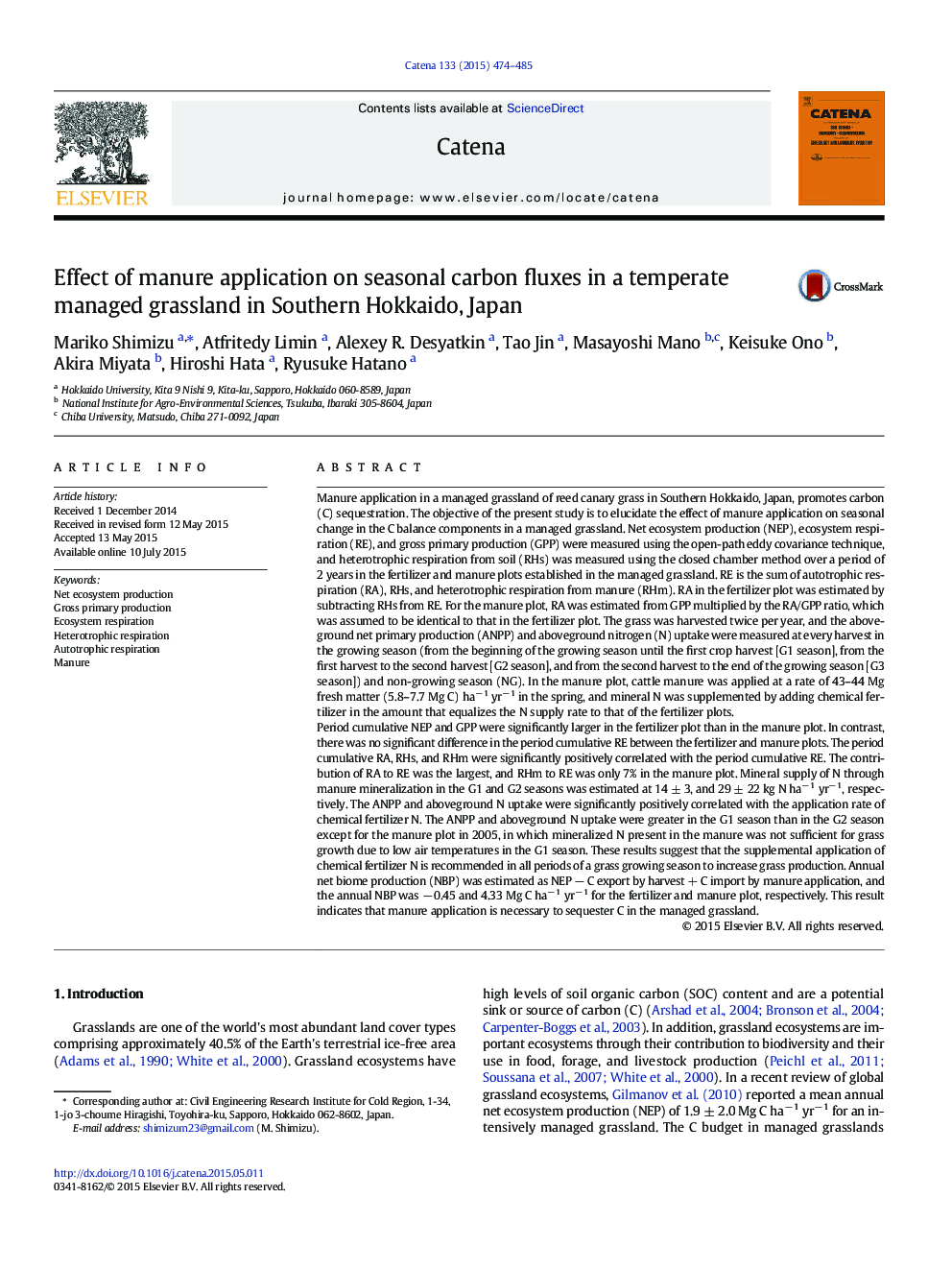| کد مقاله | کد نشریه | سال انتشار | مقاله انگلیسی | نسخه تمام متن |
|---|---|---|---|---|
| 4571066 | 1629219 | 2015 | 12 صفحه PDF | دانلود رایگان |
• We measured C balances in the fertilizer and manure plots of managed grassland.
• Manure application promoted C sequestration.
• Manure decomposition accounted for 7% of ecosystem respiration in the manure plot.
• Gross primary production was lower in the manure plot.
• Supplemental application of chemical fertilizer was recommended in the manure plot.
Manure application in a managed grassland of reed canary grass in Southern Hokkaido, Japan, promotes carbon (C) sequestration. The objective of the present study is to elucidate the effect of manure application on seasonal change in the C balance components in a managed grassland. Net ecosystem production (NEP), ecosystem respiration (RE), and gross primary production (GPP) were measured using the open-path eddy covariance technique, and heterotrophic respiration from soil (RHs) was measured using the closed chamber method over a period of 2 years in the fertilizer and manure plots established in the managed grassland. RE is the sum of autotrophic respiration (RA), RHs, and heterotrophic respiration from manure (RHm). RA in the fertilizer plot was estimated by subtracting RHs from RE. For the manure plot, RA was estimated from GPP multiplied by the RA/GPP ratio, which was assumed to be identical to that in the fertilizer plot. The grass was harvested twice per year, and the aboveground net primary production (ANPP) and aboveground nitrogen (N) uptake were measured at every harvest in the growing season (from the beginning of the growing season until the first crop harvest [G1 season], from the first harvest to the second harvest [G2 season], and from the second harvest to the end of the growing season [G3 season]) and non-growing season (NG). In the manure plot, cattle manure was applied at a rate of 43–44 Mg fresh matter (5.8–7.7 Mg C) ha− 1 yr− 1 in the spring, and mineral N was supplemented by adding chemical fertilizer in the amount that equalizes the N supply rate to that of the fertilizer plots.Period cumulative NEP and GPP were significantly larger in the fertilizer plot than in the manure plot. In contrast, there was no significant difference in the period cumulative RE between the fertilizer and manure plots. The period cumulative RA, RHs, and RHm were significantly positively correlated with the period cumulative RE. The contribution of RA to RE was the largest, and RHm to RE was only 7% in the manure plot. Mineral supply of N through manure mineralization in the G1 and G2 seasons was estimated at 14 ± 3, and 29 ± 22 kg N ha− 1 yr− 1, respectively. The ANPP and aboveground N uptake were significantly positively correlated with the application rate of chemical fertilizer N. The ANPP and aboveground N uptake were greater in the G1 season than in the G2 season except for the manure plot in 2005, in which mineralized N present in the manure was not sufficient for grass growth due to low air temperatures in the G1 season. These results suggest that the supplemental application of chemical fertilizer N is recommended in all periods of a grass growing season to increase grass production. Annual net biome production (NBP) was estimated as NEP − C export by harvest + C import by manure application, and the annual NBP was − 0.45 and 4.33 Mg C ha− 1 yr− 1 for the fertilizer and manure plot, respectively. This result indicates that manure application is necessary to sequester C in the managed grassland.
Journal: CATENA - Volume 133, October 2015, Pages 474–485
